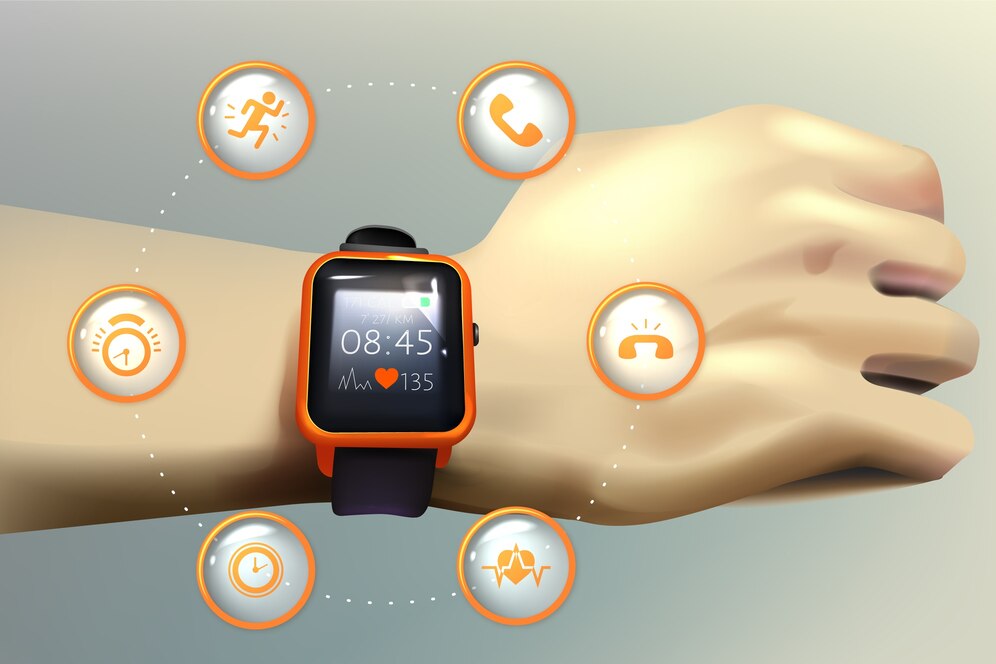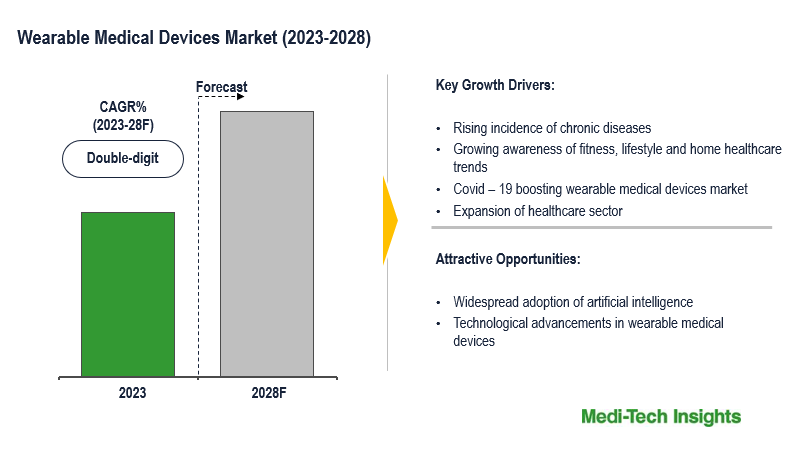
Wearable Medical Devices Market Size, Drivers, Types, Global Industry Growth Analysis 2027

The Wearable Medical Devices Market is expected to witness a healthy double-digit growth rate by 2028. The key factors driving the market are rising incidence of chronic diseases; growing recognition of fitness, lifestyle, and home healthcare trends; increased adoption of wearable medical devices since Covid-19; and technological advancements in wearable devices. To learn more about the research, fill out a quick inquiry for a sample report.
Wearables, or wearable medical devices, encompass a variety of intelligent electronic gadgets crafted for monitoring and enhancing individual health. Through the synergy of hardware, software, and mobile applications, wearables gather and assess health data, subsequently transmitting it to the cloud for advanced processing. Following are some of the wearable medical devices currently used-
- Smartwatches: Due to swift technological progress, smartwatches have become the dominant category of wearable medical devices. Initially not designed for healthcare, modern smartwatches now track various health metrics such as steps, calories, oxygen levels, and EKG reports
- Advanced Care & Alert Portable Telemedical Monitor (AMON): The Advanced Care & Alert Portable Telemedical Monitoring (AMON) is a predominant wearable medical device often present in medical practices. In doctor's offices, nurses efficiently gather vital information such as pulse and oxygen levels using this device
- Continuous glucose monitoring (CGM) represents a noteworthy progression in diabetes management. CGM technology involves a wearable sensor that autonomously tracks glucose levels throughout the day, eliminating the need for patient intervention
COVID-19 boosted the adoption of wearable medical devices
The impact of the Covid-19 pandemic on the market has been predominantly positive, with manufacturers of diagnostic devices experiencing substantial revenue growth. This surge is attributed to growing demand for wearable medical devices, particularly for self-monitoring of Covid-19 symptoms within the population. For instance, Garmin Ltd. witnessed an impressive 11.4% increase in revenue for the fiscal year 2020, with its fitness segment reporting a notable 25.8% growth during this period. The COVID-19 outbreak has expanded the role of wearable medical devices in the healthcare sector, prompting the entry of various companies introducing innovative wearables capable of detecting early warning signs of viral infections. For instance, in March 2021, Xiaomi Corporation introduced a novel wearable, the Mi Smart Band 6. The latest iteration incorporates an added functionality for SpO2 measurement, designed to monitor symptoms associated with Covid-19.
Despite the declining cases of Covid-19 post 2021, the global healthcare systems have faced significant challenges due to other infections. This has further developed a trend among individuals to adopt wearable medical devices and related products for early diagnosis of certain infections and diseases. Fitness trackers and smartwatches equipped with sensors to track a user’s physical activity and heart rate, has experienced a high demand across the globe and is expected to continue during the forecast period.
“Rising demand for wearable medical devices post Covid-19 is driven by increased awareness for fitness & healthy lifestyle, early diagnosis of diseases, and growing adoption of artificial intelligence. Industry challenges include regulatory approvals, device reliability, safety, and seamless battery integration”
- Vice President, Technology and Customer Solutions, Leading Manufacturer.
Growing Demand for Wearable Health Devices Amidst Rising Chronic Conditions
The rising prevalence of chronic diseases globally such as diabetes and neurological disorders are the prime drivers in fuelling the wearable medical devices market. Sedentary lifestyles contribute to increased mortality and higher risks of conditions like diabetes mellitus and hypertension. Notably, diabetes rates have surged, with a 3% rise in mortality rates between 2000 and 2019, causing approximately 2 million deaths globally in 2019, when combined with kidney diseases.
Additionally, according to WHO, 32% of all deaths across the globe i.e., 17.9 million people die due to CVD every year. As per European Heart Network, CVDs account for over 3.9 million deaths every year in the European region, out of which over 1.8 million deaths occur in the European Union (EU). Furthermore, a sedentary lifestyle, poor diet, tobacco use, excessive alcohol consumption, and physical inactivity are behavioural risk factors for heart disease and stroke. These factors also raise blood pressure, blood sugar, and cause overweight and obesity in people, which adds to the burden of CVDs overall. These trends anticipate a growing demand for wearable medical devices in the coming years, offering consumers the ability to monitor vital parameters such as blood sugar levels and blood pressure.

Fill out the "Quick Inquiry Form" to request a sample copy
Wearable Medical Devices Market - Competitive Landscape
Some of the key players operating in the market include Xiaomi Technology Co.; Fitbit, Inc.; Philips Electronics (acquired Biotelemetry, Inc.); Garmin Corporation; Apple, Inc.; Huawei Technologies Co. Ltd.; Polar Electro; OMRON Corporation; Sotera Wireless; Intelesens Ltd.; among others
Organic and Inorganic Growth Strategies Adopted by Players to Establish Their Foothold in the Market
Players operating in this market are adopting organic and inorganic growth strategies such as launching new products, related partnerships, and entering into mergers & collaborations to garner higher market share. For instance,
- In June 2023, Google announced the rollout of the June 2023 Feature Drop that included updates for Pixel phones, Pixel Watch, and Fitbit devices. The updates for Fitbit devices included addition of exercise modes, and daily fitness score to better understand whether the body needs rest or workout
- In May 2023, Medtronic (acquired Covidien in 2015), announced the acquisition of EOFlow Co. Ltd. a company engaged in producing EOPatch device designed for insulin delivery. This innovative wearable is tubeless and entirely disposable, positioning Medtronic to more effectively cater to the requirements of individuals with diabetes
- In April 2023, Audere introduced HealthPulse TestNow, marking the debut of the initial COVID-19 application in South Africa. This app assists individuals in self-testing by providing guidance on the execution and interpretation of Rapid Diagnostic Tests (RDTs)
- In January 2023, Masimo and Royal Philips broadened their collaboration to harness the capabilities of the Masimo W1 advanced health tracking watch, aiming to enhance patient monitoring in home telehealth. The W1 watch from Masimo integrated with Philips's patient monitoring ecosystem to advance telehealth and telemonitoring functionalities
The Wearable Medical Devices Market is expected to gain further momentum in the coming years due to the substantial presence of innovators, widespread adoption of artificial intelligence and 5G, technological advancements in wearable medical devices and and aggressive organic and inorganic growth strategies followed by the players.
Wearable Medical Devices Market Scope
|
Report Metric |
Details |
|
Market Growth Rate (Projected) |
Healthy double-digit growth rate expected by 2028 |
|
Key Market Drivers |
|
|
Types of Wearable Medical Devices |
|
|
Impact of COVID-19 on Market |
|
|
Post-COVID Trends in Healthcare |
|
|
Competitive Landscape |
Key Players: Xiaomi, Fitbit, Philips Electronics, Garmin, Apple, Huawei, Polar Electro, OMRON, Sotera Wireless, Intelesens, among others |
Wearable Medical Devices Market Key Strategic Questions Addressed
- What is the market size and forecast for the Wearable Medical Devices Market?
- What are the historical, present, and forecasted market shares and growth rates of various segments and sub-segments of the Wearable Medical Devices Market?
- What are the major growth drivers, restraints/challenges impacting the market?
- What are the opportunities prevailing in the market?
- What is the investment landscape?
- Which region has the highest share in the market? Which region is expected to witness the highest growth rate in the next 5 years?
- Who are the major players operating in the market? What is the competitive positioning of key players?
- Who are the new players entering the market?
- What are the key strategies adopted by players?
- Research Methodology
- Secondary Research
- Primary Research
- Market Estimation
- Market Forecasting
- Executive Summary
- Market Overview
- Market Dynamics
- Drivers
- Restraints
- Opportunities
- Industry Speaks
- Wearable Medical Devices Market - Size & Forecast (2023-2028), By Device Type
- Diagnostic Devices
- Vital Sign Monitoring Devices
- Sleep Monitoring Devices
- Electrocardiographs Fetal and Obstetric Devices
- Neuromonitoring Devices
- Therapeutic Devices
- Pain Management Devices
- Insulin/Glucose Monitoring Devices
- Rehabilitation Devices
- Respiratory Therapy Devices
- Diagnostic Devices
- Wearable Medical Devices Market - Size & Forecast (2023-2028), By Product Type
- Smart watches
- Activity Monitors
- Patches
- Smart clothing
- Wearable Medical Devices Market - Size & Forecast (2023-2028), By Region
- North America (U.S. & Canada)
- Europe (UK, Germany, France, Italy, Spain, Rest of Europe)
- Asia Pacific (China, India, Japan, Rest of Asia Pacific)
- Rest of the World (Latin America, Middle East & Africa)
- Competitive Landscape
- Key Players and their Competitive Positioning
- Competitive Positioning of Key Players (2022)
- Offerings Assessment, By Players
- Key Strategies Assessment, By Player (2021-2023)
- New Product Launches
- Partnerships, Agreements, & Collaborations
- Mergers & Acquisitions
- Other Developments
- Key Players and their Competitive Positioning
- Key Companies Scanned (Indicative List)
- Xiaomi Technology Co.
- Biotelemetry, Inc.
8.3 Fitbit, Inc.
8.4 Garmin Corporation
8.5 Apple, Inc.
8.6 Huawei Technologies Co.
8.7 Polar Electro
8.8 Omron Corporation
8.9 Intelesens Ltd.
8.10 Sotera Wireless
8.11 Other prominent players

